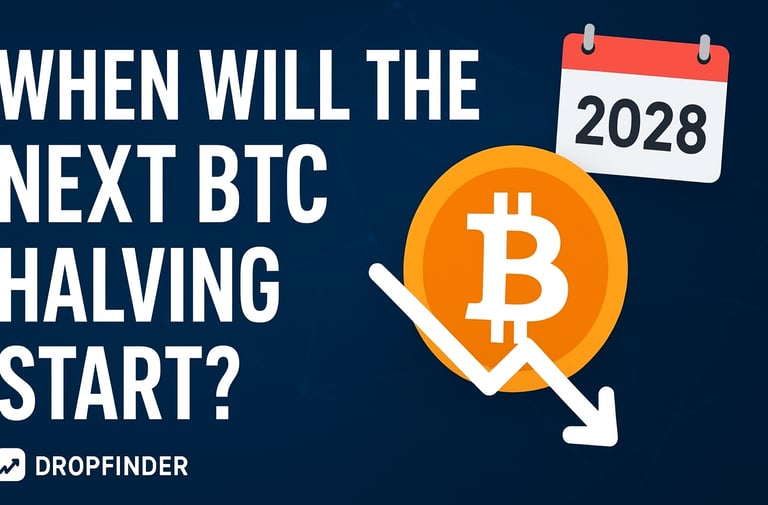When Will the Next Bitcoin Halving Start? A Deep Dive into 2028 & How DropFinder Can Help You Profit
Explore the upcoming Bitcoin halving event — when it's expected, how it works, past patterns, and strategies to ride its wave. Learn how tools like DropFinder can help you spot opportunities leading up to halving and beyond.
CRYPTO NEWS
10/12/20257 min read
Introduction
Bitcoin’s halving is one of its most powerful mechanisms. It’s a built-in feature that ensures Bitcoin remains scarce and valuable over time. Every few years, the reward that miners receive for verifying transactions gets cut in half. This event is called a “halving,” and it’s designed to keep the supply of Bitcoin limited — much like gold.
Each halving event in history has triggered huge discussions, price movements, and opportunities. But when exactly will the next Bitcoin halving start? And what can smart investors do to prepare for it? In this blog, we’ll break down everything you need to know — including the expected timeline for the next halving in 2028, how previous ones have affected Bitcoin, and how DropFinder can help you take advantage of the next big crypto cycle.
What Is Bitcoin Halving and Why It Matters
Bitcoin’s creator, Satoshi Nakamoto, designed the network so that only 21 million BTC will ever exist. To release these coins slowly, the network pays miners a reward for confirming transactions and adding blocks to the blockchain. However, every 210,000 blocks — roughly every four years — this block reward is cut in half.
When Bitcoin first launched in 2009, miners received 50 BTC for each block they mined. After the first halving, it became 25 BTC, then 12.5 BTC, and so on. The most recent halving took place in April 2024, when the reward dropped from 6.25 BTC to 3.125 BTC. After the next halving, scheduled for 2028, miners will earn only 1.5625 BTC per block.
This halving mechanism is crucial for Bitcoin’s long-term value because it reduces the rate at which new coins enter circulation. In simple terms, supply growth slows down while demand keeps rising — and basic economics suggests that when supply tightens, prices tend to go up. That’s why each halving often marks the start of a new bull cycle in Bitcoin’s history.
When Will the Next Bitcoin Halving Start?
The halving isn’t based on a specific calendar date — it’s triggered automatically by the blockchain once a certain number of blocks are mined. Each block takes about 10 minutes to process, but since network activity varies, the exact timing shifts slightly.
Current estimates predict the next Bitcoin halving will occur around April 2028, when the network reaches block height 1,050,000. Most tracking sites and analysts agree on this timeline, with some suggesting a possible window between late March and late April 2028.
When that happens, the reward will fall from 3.125 BTC to 1.5625 BTC per block. This reduction means miners will earn half as much Bitcoin for the same effort, but the scarcity effect may boost the market value — as seen in previous cycles.
Looking Back at Past Halvings
To understand what could happen in 2028, it helps to look at how Bitcoin behaved after its earlier halvings.
The first halving happened in November 2012. Before that, Bitcoin traded under $15. Within a year, it soared past $1,000. The second halving took place in July 2016. Around that time, Bitcoin’s price was about $650, and within 18 months, it hit nearly $20,000 during the 2017 bull run. The third halving occurred in May 2020, when Bitcoin was around $8,000 — and within the next year, it skyrocketed above $60,000.
The fourth halving, which happened in April 2024, is still fresh, and while we can’t yet see the long-term result, early patterns show that history may repeat itself — slow consolidation followed by a major upward cycle.
Across all these halvings, one pattern stands out clearly: the market tends to rally before and after the halving, though not immediately. Often, there’s a period of sideways movement or correction right after the event, followed by a massive bull run months later.
This delay happens because halvings take time to affect supply-demand dynamics. It’s not an overnight trigger — it’s the start of a tightening phase that builds momentum gradually.
Why the Halving Impacts Price
Bitcoin halvings change the supply rate dramatically. Imagine you’re reducing the amount of new gold entering the market by half every four years — eventually, scarcity kicks in. With fewer new BTC available, miners have less to sell, while investor interest tends to grow due to media coverage and hype. The result? Rising demand and limited supply often lead to higher prices.
But it’s not just about supply. Halvings also shift the psychology of the market. Traders and investors anticipate price increases, leading to more buying pressure ahead of the event. This self-fulfilling cycle has repeated multiple times.
However, it’s also worth noting that each halving produces a smaller percentage increase in price than the last. The first halving made Bitcoin skyrocket thousands of percent, while the later ones produced smaller yet still massive returns. As the market matures and becomes more liquid, volatility decreases.
Risks and Reality Check
While halvings have historically preceded bull runs, it’s risky to assume history will repeat exactly. The crypto market today is far more complex than it was a decade ago. Institutional players, governments, and global macroeconomic trends can all influence Bitcoin’s trajectory.
Market conditions, regulations, or global recessions can dull the halving effect. Additionally, as block rewards shrink, smaller miners might shut down their machines if mining becomes unprofitable, which can temporarily impact Bitcoin’s network strength.
Another factor is expectations. Since everyone knows about halvings, some of their effects may already be priced in ahead of time. This means the biggest opportunities may lie months before the halving, not right after it.
How DropFinder Can Help You During the Halving Cycle
DropFinder isn’t just for airdrops — it’s a full crypto intelligence platform that can help you stay ahead of market trends, especially during major events like Bitcoin’s halving. Here’s how it can give you an edge:
1. Early Discovery of New Opportunities
During halving years, thousands of new crypto projects, layer-2s, and DeFi tokens emerge. DropFinder helps you discover these projects early, track their communities, and identify the most promising airdrops or tokens before they explode.
2. On-Chain Data and Wallet Insights
DropFinder tracks on-chain activity and large wallet movements. Before each halving, institutional investors often start accumulating BTC or related assets. By watching wallet data, you can spot these trends and align your strategy accordingly.
3. Market Sentiment and Trend Analysis
Using DropFinder’s analytics, you can monitor sentiment around Bitcoin and emerging altcoins. This helps you gauge whether the market is in early accumulation mode, overbought territory, or approaching a correction.
4. Portfolio Management and Diversification
The best strategy isn’t just holding Bitcoin — it’s diversifying into projects likely to benefit from Bitcoin’s rising tide. DropFinder can show which sectors (like DeFi, AI, or real-world asset tokens) are gaining traction, helping you build a balanced portfolio.
5. Timing Entry and Exit Points
Halvings bring volatility. DropFinder’s data-driven signals can help you identify accumulation zones and profit-taking points. Instead of reacting emotionally, you can make decisions backed by data.
By combining halving knowledge with DropFinder insights, you can spot both short-term opportunities (like pre-halving rallies) and long-term plays (like emerging networks poised to benefit from increased crypto adoption).
The Ideal Game Plan for the 2028 Halving
Preparing for the halving is about timing, patience, and smart positioning. Here’s a step-by-step approach you can consider:
Phase 1: Early Accumulation (2025-2026)
Start building your Bitcoin position gradually using a dollar-cost averaging (DCA) strategy. Avoid going all-in at once. This is also a great time to explore upcoming tokens on DropFinder that are still under the radar.
Phase 2: Pre-Halving Momentum (2027)
As excitement builds, trading volumes and Bitcoin interest tend to rise. Watch DropFinder’s trend section for early market sentiment indicators. Position yourself in strong assets, but stay cautious — this phase often includes fake rallies.
Phase 3: The Halving Itself (2028)
Expect volatility. Some traders take profits just before or during the halving. Hold your long-term positions and avoid panic selling. Use DropFinder to monitor which projects are gaining traction from the halving narrative.
Phase 4: Post-Halving Consolidation (2028-2029)
After the halving, the market may go quiet for a few months. This is when patient investors accumulate again. Many who lose faith here miss the next big run. Stay consistent and keep watching DropFinder for new opportunities.
Phase 5: Bull Run Expansion (2029-2030)
Historically, a year after each halving, Bitcoin experiences a strong uptrend. Use DropFinder to identify top-performing altcoins or airdrops that are benefiting from Bitcoin’s rise. Secure profits strategically rather than holding blindly through the peak.
This disciplined approach can turn the halving cycle into a structured investment strategy rather than a gamble.
How to Combine Halving Cycles with Airdrops and New Projects
The halving doesn’t just affect Bitcoin — it often triggers renewed interest in the entire crypto market. New investors enter, liquidity increases, and new projects start launching.
This is where DropFinder can make a real difference. The platform lists legitimate airdrops and early-stage projects that often benefit from increased user attention during halving hype. Some airdrops can deliver huge returns for users who engage early — especially those related to Bitcoin-focused layer-2s, decentralized exchanges, or infrastructure tokens.
So, while waiting for Bitcoin’s long-term gains, you can multiply your exposure through carefully chosen airdrops and token hunts via DropFinder. This combined strategy blends stability (BTC) with opportunity (new tokens).
Can You Really Become a Millionaire from the Halving Cycle?
Becoming a crypto millionaire isn’t about luck — it’s about preparation, patience, and information. The halving provides a predictable cycle in a market that’s often chaotic. If you position yourself correctly before the event, avoid overtrading, and use analytical tools like DropFinder to spot new opportunities, the odds can lean in your favor.
Those who made fortunes in previous cycles didn’t just buy Bitcoin once and forget it — they studied market patterns, participated in airdrops, diversified early, and stayed disciplined when others panicked. The halving rewards long-term thinkers, not gamblers.
However, it’s crucial to stay realistic. Markets evolve, and what worked in 2016 may not work exactly the same way in 2028. Adaptability and data-driven decisions remain key.
Frequently Asked Questions
When exactly will the next Bitcoin halving happen?
The next halving is expected around April 2028, once Bitcoin reaches block height 1,050,000.
Will Bitcoin’s price definitely rise after the halving?
Historically, yes, but it’s not guaranteed. Other market factors like regulation and global economy also influence price.
Can DropFinder help me track halving-related tokens?
Yes. DropFinder lists tokens, airdrops, and blockchain projects that gain traction around major crypto events, including halvings.
Is it too late to start investing in Bitcoin before the halving?
Not at all. Accumulating early through small regular purchases can still yield strong results, especially if you plan to hold long-term.
Conclusion
The next Bitcoin halving will likely take place in April 2028, reducing block rewards from 3.125 BTC to 1.5625 BTC. This event is central to Bitcoin’s deflationary design and often sparks major shifts in the crypto market.
If history is any guide, the months leading up to and following the halving could offer both volatility and opportunity. By combining a disciplined investment plan with tools like DropFinder, you can gain early access to promising projects, time your entries better, and maximize returns across the next cycle.
Whether you’re a long-term believer in Bitcoin or a crypto explorer looking for the next big wave, the 2028 halving could be your moment — if you prepare wisely.




